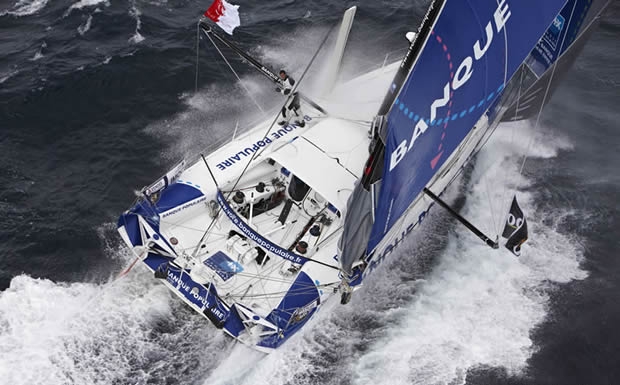
IMOCA 60s - VPLP's views
While there are six new IMOCA 60s racing in this Vendee Globe – interestingly (touch wood) none of them have broken yet... – of these, four are from the union of VPLP and Guillaume Verdier’s teams, who previous designed Kito de Pavant’s Groupe Bel and Marc Guillemot’s Safran for the 2008 race, which obviously have both now fallen by the wayside in this Vendee Globe.
Of the new VPLP-Verdier designs Vincent Riou’s PRB was taken from the hull moulds of Safran, while Jean-Pierre Dick’s Virbac-Paprec 3 is a wholly new generation design, and sisterships Banque Populaire (formerly Michel Desjoyeaux’s Foncia) and MACIF are sisterships, with MichDes’ company Mer Agitée having had a strong input into their design, the hulls for both boats built by Green Marine in the UK. The latter two boats are particularly ground-breaking with their the cut-away bulwarks, convex foredeck (designed to lower CoG) and V-configuration daggerboards, designed to provide lift as well as prevent leeway, etc.
Read about Banque Populaire when she was Foncia here and a pre-Transat Jacques Vabre 2011 update on her and sistership MACIF here
Read our guides to PRB and Virbac Paprec 3 - Pt1 and Pt2
Vincent Lauriot Prevost (left) with Quentin Lucet
Also to consider is that the new builds since the last Vendee Globe have all had to comply with the latest iteration of the IMOCA rule, limiting rig height to 29m off the water, number of sails carried on board and also upping the AVS (angle of vanishing stability) ‘worst case’ from 108 to 110° and specifying a maximum righting moment of 32 tonne metres.
So given the new rules - are the new boats faster? It is safe to say ‘yes’. Of the top six in the Vendee Globe, currently only one – Alex Thomson’s Hugo Boss – is an old generation boat, although this is also testament to the skill of the sailors driving these boats, who are some of the best in the fleet.
“It depends on if the boats from four years ago have been modified or not,” says Vincent Lauriot Prevost. “If we take a boat like Safran, which has had a lot of improvements made to it, I think the difference is quite small between the new generation, after all PRB has the same hull as Safran, but to comply with the new rules she has a shorter mast and is a bit lighter.” Rumour has it that ‘a bit lighter’ = 300kg, significant on a boat displacing around 7.2 tonnes.
We can’t help feeling that a rule that pushes boats to be designed ever more light has to lead to unreliability for this seems to be where the IMOCA 60 rule at (although saying this is the not the six boats boats that have broken so far in this Vendee Globe). For as Lauriot Prevost maintains, the best performance in an IMOCA 60 is to be gained in boat that is light but with maximum power – just like racing multihulls. “When you are downwind in waves, the lighter you are, the sooner you surf on waves. When you need to be heavier – if you need extra power or inertia - then you have the [water] ballast for that.”
In an attempt to keep the older generation boats competitive, they have been allowed to maintain their original mast height. This has been the case for Groupe Bel and Safran (the former with a wingmast, the latter a fixed rig - with its unique carbon fibre track) even thought they have both changed their masts in this Vendee Globe cycle.
More powerful hull shapes
On the new boats, thanks to the new maximum mast height restriction, Lauriot Prevost says that they have had to look elsewhere to develop power and this has come from the hull shape, with increased beam and more significant chines extending further forward up the length of the hull.
Inevitably rules have a tendency to typeform boats and with the maximum righting moment rule in place, so all the teams effectively have been given a target to hit, so the new boats have been pushed to its limit, which is slightly higher than the older generation VPLP-Verdier boats as they were originally designed. Many of these have since had modifications made to their fin/keels, and in particular enlarging and rearranging their giant water ballast tanks down below and lowering centre of gravity to bring them in line with the new builds.
“They are much more powerful than they were four years ago,” confirms Lauriot Prevost. “If Virbac Paprec 3 is close to the maximum, a boat like Safran is not that far away too.”
So a higher righting moment should mean greater loads, making the boats harder to sail, however the designer doesn’t believe this to be the case, pointing out that it is only upwind or power reaching when the maximum righting moment is achieved.
Another development in the last four years has been the skippers discovering how much faster their boats go faster when they are heeled more. “Before they were heeling 15-20°, now it is 20-25° to reduce wetted surface area,” says Lauriot Prevost. “It is strange because the efficiency of your sail plan should be impacted by this heel, but the effect is more than compensated by reducing wetted surface area. The friction drag for the hull is about 70-75% of the hull plus appendage drag.”
A power feature of the hull VPLP-Verdier haven’t gone overboard with are the chines, although they have got more pronounced, extend further forward and, significantly, are lower.
“You have to stay reasonable still,” says VPLP designer Quentin Lucet, “because in the studies we did for Virbac Paprec 3 we looked at some hulls that were more powerful, with the chine lower still, but we preferred to remain reasonable.”
Lauriot Prevost butts in: “...just to preserve the skipper, to dampen it a bit. People say that these boats are brutal enough.”
Refined water ballast
As mentioned, since the last Vendee Globe, teams have been spending a lot of time refining their water ballast configurations and several teams for example have gone from having three to five tanks each side. Mike Golding who now has five tanks on each side aboard Gamesa, equates this to providing ‘more gears’. Lucet gives his opinion: “It allows more tuning according to the wind speed, whereas four years ago maybe it was not so refined. It allows us to have a ballast condition allowing the boat to be light and fast, let’s say, more than before.”
On some boats there is a trend away from using forward ballast – the Juan K-designed Cheminees Poujoulat for example doesn’t have forward tanks, while Mike Golding says he rarely uses his. However VPLP-Verdier are still fans - they have reduced the size of the forward tanks, but have not dispensed with them. “The forward ballast is more like a comfort ballast. You don't go faster with it, but the boat is definitely slamming less,” says Lauriot Prevost.
Lucet adds that the location of the forward tanks (along the centreline) also means that they no longer have much effect on the IMOCA 60’s ancient ’10 degree rule’ (whereby a boat must heel by no more than 10 degrees with all movable ballast deployed). They are purely there to add displacement.
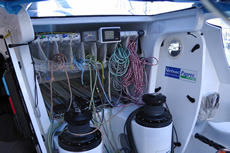 |
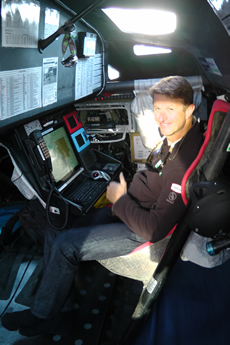 |
Daggerboards
The twin daggerboards all the boats now have, have also been developing over this cycle. For the last race, Safran was the first to feature curved (ORMA 60-style) daggerboards, aimed at generating lift as well as preventing leeway and these now feature on both PRB and Virbac Paprec 3. The Desjoyeaux V-configuration boards do much the same job in this respect on Banque Pop and MACIF. But, according to Lauriot Prevost, this style of board also has the effect of reducing pitching, seemingly locking the boat to the water and this also helps to reduce slamming. “That is something that you wouldn’t have from a daggerboard orientated the other way around,” observes Lucet. And with less slamming, this in turn presumably improves the air flow over the rig as well as reducing shock loads that would be otherwise be reverberating throughout the boat.
According to Lauriot Prevost, the size of the daggerboards has also started to go down (there was a time when you couldn’t build them big enough..) as teams and designers have learned more about the relationship of using varying degrees of board and keel cant for different conditions. “There have been some interesting tests between the trade-off in certain conditions between having the daggerboard to leeward down, versus having the canting keel half down with the ballast. There have been a lot of refinements on this side," says Lauriot Prevost.
“We made a lot of studies of the interaction between the components of side force from the centreboards, the hull and the keel canted to different angles and it is not evident like it was before that the centreboard is the best solution when you are tacking in light wind conditions for example. So there are times like that when you don’t need maximum power, that you can come to a different solution.” Less board also means less drag so skippers are now partially lifting the board even when they are reaching as this improves acceleration.
Keel foils
While Safran’s premature exit in this Vendee Globe indicates that titanium might not to be the best choice of material for keel foils, the school seems to be out in the carbon v steel debate. There now seems to be four main options for building keel foils – milled stainless steel (as Foncia won the last race with), fabricated steel (steel girder and frame with the foil shape formed by plates – some teams have been using high tech steels for these), solid steel keels with a hollow in their centre and carbon fibre foils. While Safran and Groupe Bel both originally had carbon foils, option three is currently the favourite with VPLP-Verdier and being used on Paprec, PRB and MACIF. This, they say now has a weight comparable with that of a carbon fin, while being thinner and with a slightly lower CoG.
In terms of how their boats have been optimised, Lauriot Prevost says that there hasn’t been much change since the last Vendee Globe. “Reaching is important, downwind is important and when you go upwind back to Les Sables d’Olonne that is important as well! So you need them to be polyvalent [ie all-rounders], but for sure these boats are more orientated for off the wind more than upwind. They try to 'lose' the minimum upwind.”
Other significant developments for this race has been several boats adopting North 3Di for their sails with the benefits of lightweight and maintaining their shape and more carrying composite rigging, either PBO or in some cases carbon. The downside of these developments is that they place more load on the deck gear – from winches to sheaves and blocks and jammers, since they have substantially less elasticity.
Rigs
The school also still remains out on the wingmast-deck spreader v fixed rig with fixed spreaders v fixed rig with bendy spreaders for rigs. Lauriot Prevost says that they recommend a fixed mast, due to their marginally better record of reliability (as born out by this Vendee Globe – the only rig to fall to date has been the wingmast on Sam Davies’ Saveol).
“With your standard mast, you have got good rigging, because sometimes you lose the mast because your rigging breaks, not because of the mast. Kito [Groupe Bel in the last Vendee Globe] lost his wingmast because of the rigging and during the Volvo Ocean Race they have lost masts because of a broken rigging attachment, so often it is not the mast itself. The thing is that when you have the wingmast and it is rotated it is not as stiff as a fixed mast,” observes Lauriot Prevost.
With less rigging and spreaders and a cleaner section, the wing represents the low windage option and these days they carry only a very minor weight penalty compared to fixed rigs. However for the singlehanded skipper they require more attention – how they are rotated is of vital importance as is the role of the runners.
The one design compromise
VPLP are currently working for IMOCA on a compromise solution between the boats that exist now and a one design, by making some aspects of future IMOCA 60s one design, in an attempt to reduce escalating costs. Their findings are to be presented to the class after the finish of this Vendee Globe.
Obvious candidates to go one design are the keel canting mechanism, even possibly the keel itself or the permitted materials for the foil. They plan to have a drive to make the water ballast tank configuration standard (eliminating their present complexity). They are also proposing a pressure which hull panels must be able to withstand. “So, if you want to make a sandwich of 50mm thick foam or a 3mm thin single skin bottom, it is possible,” explains Lucet.
Possibly the biggest issue is the rig. With this it would seem sense to go down the Volvo route of having a minimum weight for the tube and a minimum height for the rig’s centre of gravity, however it would be good to do this in a way that legislates for a skipper's preference to go wingmast or fixed and not to force teams down particular avenue when it comes to personal perferences such as foretriangle height, for example.
Lauriot Prevost also observes that rig weight and CoG limits then pushes teams into minimising the weight of the rig’s fittings and fixtures. “You take the risk there because you want to save weight where it is not controlled.” He observes the VO70 rule where despite having this in place there were still two dismastings in the last fully crewed round the world race. It is vital when creating rules to understand what their knock-on effects will be.
A further issue is that this all has to be done in a way so that the new, theoretically cheaper next generation boats maintain a similar performance or marginally better than the existing fleet.
The IMOCA 60 as a development class continues to fascinate and one has to recognise that we wouldn’t be writing an article like this, if the fleet was all one-design.
Not related to VPLP, but this is quite interesting, down below on Bernard Stamm's Cheminees Poujoulat - unfortunately the sound is missing (think silent film) but it shows the canting chart table and the innovative 'stacking train' - the entire stack moved around the boat on a track slung from the underside of the cabintop.

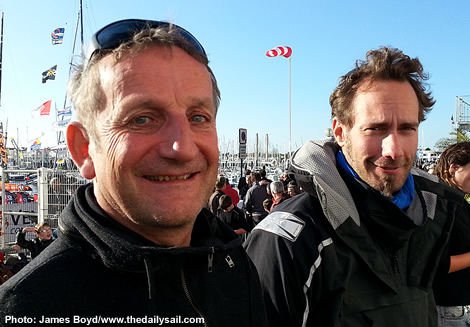
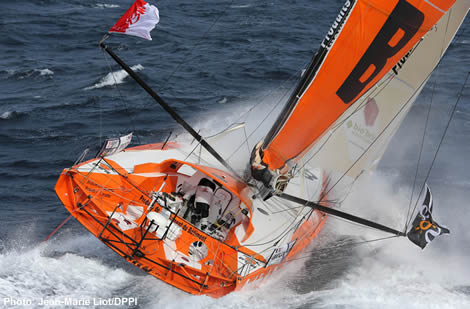
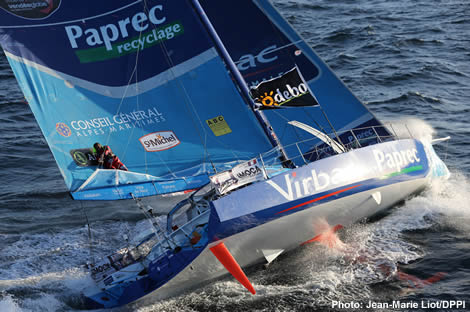
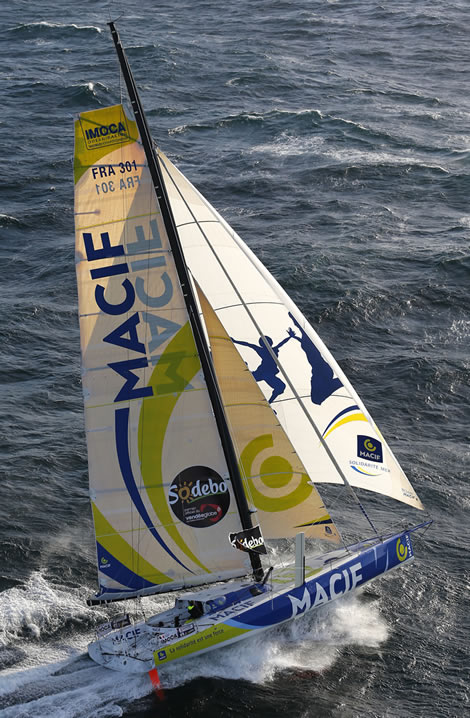










Latest Comments
Add a comment - Members log in